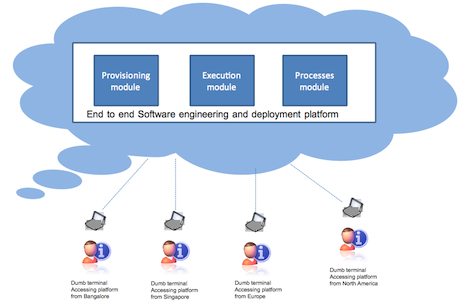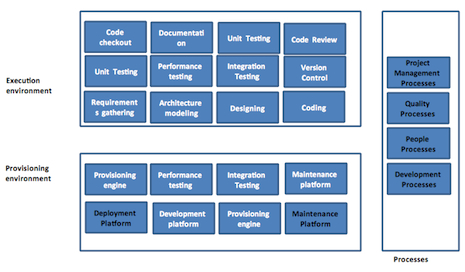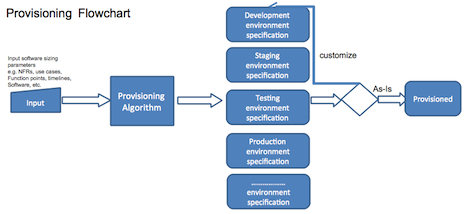Abstract
Industry-standard cloud models such as Infrastructure as a Service (IaaS), Platform as a Service (PaaS), and Software as a Service (SaaS) support only hosting software end product (software applications). However none of these existing cloud models supports real-time software engineering, maintenance activities, and enabling processes on the cloud.
The envisaged EaaS platform provides the ability to intelligently provision development environments in the cloud. Post-provisioning, it provides an environment to execute end-to-end software development lifecycle activities (SDLC), such as requirements engineering, architecture, design, development, and testing. The platform also supports continuous software maintenance in the cloud. Apart from software engineering and maintenance, the platform provides enabling processes to execute the complete SDLC.
Software development and maintenance activities in the cloud can be performed by connecting remotely to the EaaS instance using dumb terminals.
Introduction
The software application lifecycle broadly consists of two key phases, application development and application deployment. Conventionally application development and hosting happens on-premise (within the enterprise boundary). With the advent of cloud, it is leveraged only for application deployment however; the application engineering and maintenance activities continue to take place on-premise, that is, not in the cloud.
On-premise (outside of cloud and within the enterprise boundary) application development requires up-front investments and planning, in the form of procuring desktops, servers, and software applications. Not only this, it means establishing complete development and maintenance processes and adhering to them.
However, today, no turnkey solution exists which can provision an application development and maintenance ecosystem (development machines/nodes running with hardware, software, servers, processes) off-premise (in the cloud) based on inputs of certain parameters such as application size in the form of use case, function points, duration/timelines, scope, etc.
EaaS provides the turnkey solution to not only provision the complete development ecosystem (hardware, software, desktops, servers, processes) but also enables the complete application lifecycle development and deployment activities in the cloud with the ability to ramp up and ramp down resources.
The cloud-based development environment can be accessed from the in-house machines or dumb terminal by logging into the provisioned system on cloud. This in turn supports the necessary application development, and maintenance lifecycle activities such as coding, version control, check in, check out, code reviews, unit testing, code execution to name a few.
This software provisioning and execution platform will be useful for many enterprises, entrepreneurs, and individual professionals to rent it in “pay as you use” manner. By requesting the environment on demand and releasing it as soon as the work is done, a lot of lead time in conventional hardware, software procurement and money can be saved.
The platform can be accessed by logging into the system using a dumb terminal (a machine with very minimal CPU and memory configurations) that will facilitate software creation at anytime from anywhere without needing to rely on pre-configured desktops or laptops.
Challenges
There are multiple challenges with the existing model of on-premise or off-premise (cloud hosted) application development such as:
-
Current models such as Infrastructure as a Service (IaaS), Platform as a Service (PaaS), Software as a Service (SaaS) and associated technology vendors such as Amazon, Microsoft, Google, Salesforce, etc. support only various application deployment models which have the ability to provision hardware (nodes) and either allow software installation (IaaS) or provide software service APIs (PaaS) or finished applications (SaaS). However, none of these models supports real-time application development lifecycle (engineering), or maintenance activities including support for the associated software processes.
|
Platform |
Service |
Platform Vendor |
|
IaaS |
Infrastructure provisioning |
Amazon |
|
PaaS |
Infrastructure provisioning, Platform APIs, programming language support |
Microsoft, Google App Engine |
|
SaaS |
Finished product/application can be directly accessed. |
Salesforce.com, Google Apps, email, etc. |
|
EaaS |
End to end application development lifecycle activities, execution support including persistence |
None as yet |
-
Application development using IaaS, PaaS, and SaaS models has to be done on-premise (outside of cloud and within the enterprise boundary), which means configuring desktops with the requisite development environment.
-
The existing IaaS, PaaS, and SaaS models do not have the ability to intelligently recommend provisioning environments for various activities such as development, testing, production, etc. based on specific application sizing parameters.
-
On-premise development models demand upfront investment (CAPEX) in real estate, hardware, software, and processes which makes the overall software development costly.
-
On-premise development models inhibit the ability to work anytime and from anywhere as they are tightly-coupled with and dependent on specific hardware, software, and processes. This set-up usually exists only in the enterprise boundary on a pre-configured desktop or laptop.
-
Ability to elastically ramp up, ramp down, and provision various test, development, maintenance environments is costly and time-consuming with on-premise.
-
Software needed in on-premise environment requires individual software licenses to be bought from individual vendors.
Proposed Solution – EaaS platform
As depicted in the following diagram, the proposed EaaS system consists of primarily three modules.
Figure 1.0: EaaS Platform Block diagram
The provisioning system is intelligent to recommend sizing for various environment such as
-
development
-
testing
-
staging
-
production environment
based on input of various parameters such as application size in the form of
-
number of use cases
-
function point
-
project timelines, etc.
The provisioning system will also allow the user to select and install specific software development packages or utility software applications for executing the main software project.
The execution environment will support day-to-day software development/maintenance lifecycle activities such as project planning, requirements gathering, architecture, design, code check-out/check-in, coding, profiling, unit testing, integration testing, version control to name a few.
The process module will provide systems and processes for executing a software project at a specific project quality standard such as CMM, ISO level and will provide necessary project management, quality measuring and tracking software systems on the cloud.
The cloud-based development environment will be accessible from on-premise machines or dumb terminals by logging into the provisioned system in the cloud. After which, necessary application development, maintenance lifecycle activities such as coding, version control, check in, check out, code reviews, unit testing, code execution, etc. can be performed.
Details of the Sub-system
The following figure depicts the platform support for key activities, functions. The platform has three key logical modules as provisioning, execution and processes as depicted and detailed in the diagram below.
Figure 2.0: EaaS platform components
Provisioning Environment
The following figure, in the form of block diagram, explains the high-level steps in platform provisioning.
Figure 3.0: Provisioning Module
The provisioning system will rely on a wizard-based workflow that will take one or more inputs from the user, such as application size in terms of function points, number of use cases, timeline within which the project needs to be executed, and associated software to be provisioned. Based on these inputs, the provisioning algorithm will compute sizing for various aspects of the development environment, such as number of nodes, server specs, software, and processes for specific environment such as dev., test, production, etc.
The user can either accept the recommended environment or tweak it based on his/her needs by going back and forth in the workflow.
After confirmation from the user, the provisioning module will provision the necessary environment.
The following are some examples of environments that can be provisioned (provisioning environments are not limited to these):
Development environment – to perform software development, engineering activities.
Performance testing environment – to perform activities such as performance testing, benchmarking.
Integration testing environment – to perform integration testing activities.
Production environment – the environment where the software application will be deployed for end users to perform actual business functions.
Maintenance environment – the environment where software maintenance activities, bug fixing and testing will be done. This environment can also be treated like a staging environment.
In real life, the software project may need more or may not need all of these. Also the configuration for each of these environments would be variable, dependent on client needs, and dependent on the needs of the particular project.
Execution Environment
The execution environment allows users to perform complete end-to-end software engineering activities in the cloud, such as:
Requirements gathering/engineering – tools to capture and document software engineering requirements in the form of use cases, workflows, business interactions, or change requests.
Architecture modelling – tools to define and depict various architectural views, such as business, technology, deployment, information view of the proposed system.
Module design – tools to design various components, sub-systems of the software application.
Coding – integrated Development Environment (IDE) to write, compile, run, and verify the actual code.
Version control – source control for versioning of code, documents, etc.
Unit testing – tools to unit-test the code for a particular use case.
Software documentation – tools to support documentation activities during the lifecycle.
Processes
While performing software engineering and support activities, various supporting processes are needed that are enabled through this module.
Project Management processes – processes to support project management activities during the software development lifecycle such as project plan creation and tracking, milestone creation, planning customer billing milestones, resource planning and allocation, etc.
Quality processes – quality processes to support software development lifecycle activities such as code review, defect logging, defect fixing, estimation, etc.
People processes – processes such as leave planning.
Development processes – processes such as version control, code back up, conducting reviews, etc.
Benefits of the Solution
-
Ability to support an end-to-end software environment in the cloud (provisioning, execution-software engineering and deployment, ecosystem-processes).
-
For end users, using the environment doesn’t require a large upfront investment but relies on resource or transaction-based pricing (CAPEX to OPEX).
-
Ability to work anytime from anywhere by providing necessary credentials to enter the cloud.
-
Ability to increase or decrease the number of development nodes as per the demand of the application development lifecycle, provision various test and release environments.
-
Provide suggestions about distributing the load across various phases in lifecycle to help optimize and plan resources and cost.
-
All software licenses can be either provided from the provisioning environment within the cloud or made to custom install in the cloud environment.
-
The platform enables channels of co-creation and harnesses collective intelligence for the distributed workforce.
Summary
Conventionally, software development activities require a lot of time because of the effort involved in planning, procuring, and execution. Not only are the procurement lead times very lengthy, but also consume extraordinary upfront investments in hardware, software and at times defeat the business case in the short term.
The cloud avenue to plan, procure, and execute end-to-end software engineering activities will not only help eliminate the challenges mentioned above, by allowing enterprises to in essence “rent” only what is needed at any point in the SDLC, but also enable the anytime-anywhere development in this distributed workforce world.
Acknowledgments
Author would like to acknowledge the efforts of Naveen Kumar Principal, Infosys Ltd. and Sameer Suryakant Kulkarni, Content Architect, Infosys Ltd.
About the Author
Sudhanshu Hate (Suds) is a Senior Technology Architect at Infosys Labs, Infosys Limited. He has more than 14 years of industry experience working across various stages of SDLC. For last several years, he has been responsible for technology research, envisioning, building, and consulting on Microsoft technology based solutions.
His areas of work span across cutting-edge technology research, architecture reviews, defining technology strategy, point of views with focus around Microsoft .NET stack, cloud (Windows Azure), big data, and high performance computing
Sudhanshu has co-authored two books: ASP.NET 4 Social Networking and .NET 4 for Enterprise Architects and Developers. He has also written several papers and presented at various conferences.
Note: The author has a pending patent on this very subject.





























































